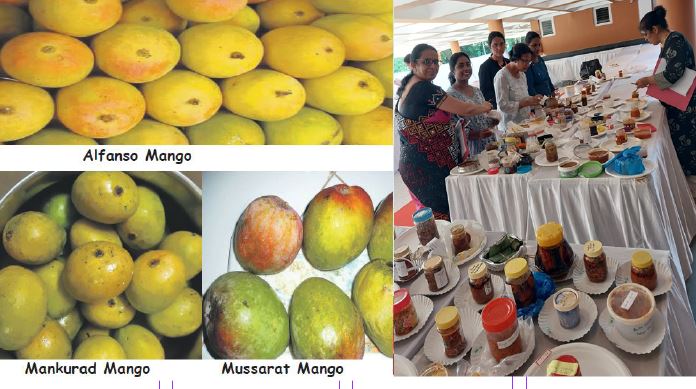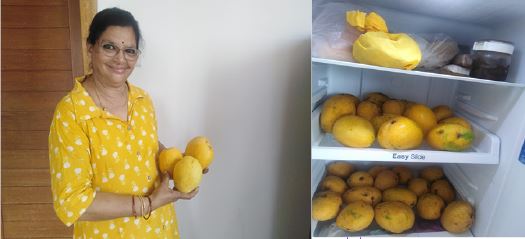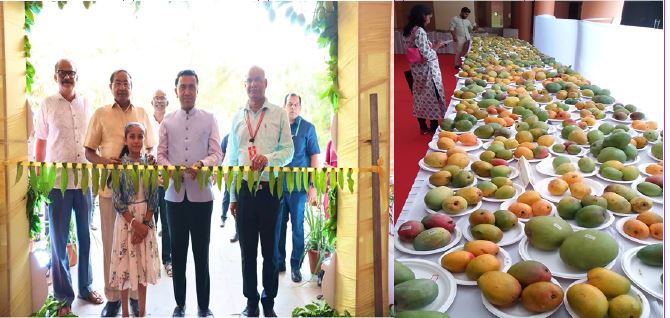GOA MANGO SHOW 2024…at Kala Academy venue on May 17-18, 2024, FF…Chief Minister Dr Pramod Sawant with Agriculture Minister Ravi Naik and Directorate of Agriculture Director Nevil Alphonso take a closer look at the 5,000 mangoes on exhibit for the show, as well as the competition entries, with mango fan mail trailing them to take pictures or selfies! There is no excitement like mango excitement and Goa can boast of at least 35 to 40 varieties of mangoes beginning with the most loved Mancurad or Malcurado, Goan Alphonso (don’t confuse with Ratnagiri Devgad mango), Hilario, Salcete Mussarad, Fernandin, Furtado, Colaco, Bishop, Malguesh, Xavier, etc. It was a breathtaking show-off of mangoes from Goa and hybrid varieties from other states too with familiar names like Kesar, Mallika, Sindhu, Neelam and the hefty Noorjahan being cultivated in Goa now. Is the mango the national fruit of India and state fruit of Goa?
By Tara Narayan
MAY is the mango month and everyone talks mangoes in Goa. One of the most joyous sights of my life in capital city Panaji is walking around or riding around on my two-wheeler to come to a stop before these amazing sightings of mango-laden trees here, there and everywhere from individual enviable residences to housing complex garden grounds…just to look at the amazing scene of mango trees loaded with mangoes green and ripening mangoes. I love my Panjim and come April and May I get my cheap thrills sight-seeing mango trees up hill and downhill everywhere!
Mangoes are a major fruit crop in the Konkan states including Goa and Goa enjoys quite a history of mango cultivation (there must be something like 35 to 40 Goan mango varieties alone)…and ever since I can remember I’ve been visiting the Directorate of Agriculture’s officially organized mango shows. This year around the official Directorate of
Agriculture Mango Festival 2024 happened over two days, May 17 and 18, 2024 at the Kala Academy spaces in Panaji.
There was on exhibition something like 5,000 mangoes plus (three per exhibit), plus, plus and a general melee of mango lovers, mango farmers, mango researchers, mango crazy public insisting on lifting mangoes with their hands here and there to guess the weight of a mango or inhale the fruit — despite eagle-eyed watchpersons admonishing don’t touch!
There were the usual for exhibition only an competition sections and the competition section also included a spread of mango preparations entered by mango crazy housewives traditional and modern – it’s a veritable spread of mango products, mango ripe treats…mango jam (mango jam “mangada” is to die and live for), mango cake, mango custard, mango halva, sun-dried mango layers also called “papad” or “leather”…then the much-loved green mango pickles of “miskut” and “bharilyo amlyo” which are whole green baby mangoes, stuffed with an aromatic masala combo…hey, what an amazing cornucopia of sweet and sour mango pickles, squashes, sherbats, mango wine! Enough to delight any mango-loving soul or something like that.
THIS year it’s the “bharilyo amlyo” or “bharlelya torache lonche” which won my heart and palate! One competition entry had these utterly delectable “bharilyo” or masala-stuffed mangoes” neatly wrapped in per piece in banana leaf parcels, you unwrap, savor and are tempted to steal one parcel away wrapped in a tissue paper! If it’s mango pickle you want to eat in Goa go for the “bharilyo” baby mangoes, some of which are water-pickled mangoes called “chepnim” but stuffed with enticing masala oozing in oils of mustard or coconut or may be sesame or my favorite physically cold-pressed rice bran oil…the bharilyo mango breaks into four quarters and one may relish the high of tart hot or tangy crunch of flavors.
My way to eat a bharilyo mango is to break into hot desi ghee-laced ambemor Pune rice, then the meal washed down with chaste cooling thin buttermilk, then afterwards a long siesta on the cool floor. Such mango and lemon pickles marry well on a hot summer day’s simple menu of “dahi-bhat” or curd-rice down south India. I also like to use the Pune-associated Indrayani rice to make my exotic curd-rice, it’s a very flavorful rice variety which only rice connoisseurs know about! (Only Swati Kamat at the Panaji market – M/s Atchut Vishnum Kamat – stocks ambemor and Indrayani rice.)
AFTER my Guju mango choonda I love the Goan bharlelyo torache lonche (masala stuffed water mangoes), not necessarily the fiery ones but say a masala redolent of ambotik or recheado masala using mild Kashmiri chilies instead of Canacona hot “khola”which may burn tongue and everything else inside body beautiful.

SORRY, I couldn’t make it for the first inaugural evening when Chief Minister Dr Pramod Sawant and Agriculture Minister Ravi Naik made their rounds after the inauguration of the mango festival, posing for paparazzi and fans with various heavyweight mangoes in hand (there was a fascinating hybrid variety named Noorjahan, a Madhya Pradesh mango variety, possibly the heaviest mango at the two-day mango show, upto five kg, sells at Rs1,000 per piece if I recall right).
Alas, by the second evening things were pretty much in an abandoned state and in any case one could only look at the leftovers at the mango preparations of the competition tables — some of the piece de resistance entries already in a state of rot, with flies buzzing around.
Some like me did venture to taste despite the many admonitions not to taste…why not?! The judges had finished their judging the previous evening and surely the public may taste what’s left if the owners don’t mind. There were mango chutneys, the much loved Goan sasav, mango squashes, sherbat, all manner of desserts but the over sugar-laden stuff put me off, you must know sugar in anything only makes one feel more thirsty for water, only delicious water.
I wanted to buy one of the flavorful cubed green mango miskut pickles and looked for the owner (Pramila Salgaonkar of Pernem) high and low to ask her if she would put a price on her pickle and give it to me, but in vain. At the end of the day the various zonal offices of the Agriculture department collect the mangoes on exhibit, and those festooned everywhere at the venue, and the owners may or may not come and pick up their entries. If no one turns up to claim I dare say the staff have a ball distributing the stuff to each other for all the hard work they’d put in to organize the whole show! Agriculture department staff are lucky in this sense, although I wish though some of the mangoes would be put up for sale for the public with owner’s prior permission, no?
THINKING I would buy some mangoes I looked but there was just one limited table at the entrance where the limited stocks of mangoes for sale had all been sold out; I bought fresh kokum agal (concentrate for making the refreshing staple of kokum tival or solkoddi for Konkan home meals), and there was mango squash and caju packets, someone was offering aam ka panna in paper cups for Rs150 to quench thirst!
Goa has quite a roll call of mangoes because the story is that it is the Jesuit priests who came during the Portuguese colonial years who taught the Goan natives the art of grafting and getting superior mango fruit! Of course the ICAR (now ICAR-CCARI) showpiece varieties of mangoes were on exhibit, especially spotlighted beneath a decorative pandal…Goa has something like 35 to 40 varieties of mangoes and most of them have been cultivated courtesy one Dr P A Matthew at the ICAR grounds in Old Goa, read his book “Mangoes of Goan Origin” published by ICAR, Dr Matthew must have long since returned to his home town of Kozhikode in Kerala.
Most everyone wanted to pose with the largest mango which I remember right was named “Noorjehan” (after the Moghul queen of Shah Jahan), it weighed four to five kg! Anyway, this is to say although I didn’t buy mangoes, nor have I eaten mangoes to my heart’s delight yet this mango season…it so happened my friend Satyashree Gandham (who makes sourdough bread) had her mother Manorama Devi visiting her from Vijayawada in Andhra Pradesh, and mother dear came loaded with the Andhra favorite mango called “banganpalli”…a largish flavorful not so sickly sweet like Goa’s mankurad or malcorado! We had banganpalli mango puree with hot, hot puri that day courtesy a loving mother’s gift.

Needless to say there are mangoes and mangoes the country over for India is a mango country and celebrates the fruit whenever mango trees bloom into blossom and fruit…mango leaves are considered auspicious in toran (garland) at all religious functions and they’re stuffed in copper pots of Gangajal (holy Ganga river water), we worship the mango tree…so happy mangolicious celebrations in Goa and all that. Make the most of mangoes before the monsoon rains really arrive and mangoes get infested with worms! Check before buying.mangoes, nor have I eaten mangoes to my heart’s delight yet this mango season…it so happened my friend Satyashree Gandham (who makes sourdough bread) had her mother Manorama Devi visiting her from Vijayawada in Andhra Pradesh, and mother dear came loaded with the Andhra favorite mango called “banganpalli”…a largish flavorful not so sickly sweet like Goa’s mankurad or malcorado! We had banganpalli mango puree with hot, hot puri that day courtesy a loving mother’s gift.
Needless to say there are mangoes and mangoes the country over for India is a mango country and celebrates the fruit whenever mango trees bloom into blossom and fruit…mango leaves are considered auspicious in toran (garland) at all religious functions and they’re stuffed in copper pots of Gangajal (holy Ganga river water), we worship the mango tree…so happy mangolicious celebrations in Goa and all that. Make the most of mangoes before the monsoon rains really arrive and mangoes get infested with worms! Check before buying.
